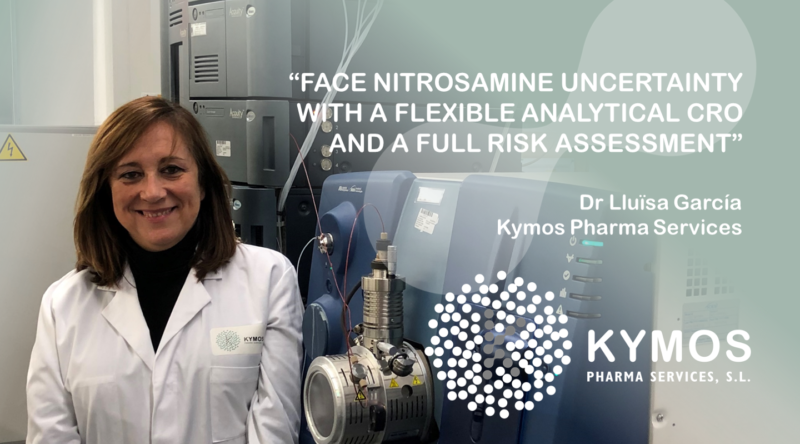
“Face Nitrosamine uncertainty with a flexible analytical CRO and a full risk assessment”
Dr Lluïsa García, Kymos Pharma Services
There has been much attention surrounding the discovery of N-nitrosamine impurities in blood pressure medicines known as sartans. We explain how this situation has arisen and interview our expert, Dr Lluïsa García, PhD in Organic Chemistry, Co-Founder and COO at KYMOS about current concerns and how to tackle them.
“We are facing a worldwide challenge but KYMOS has a history of developing new analytical methods, service units and even entire departments to address sudden and unexpected needs of the biopharmaceutical market,” begins Dr García. “It is our job as a CRO to stay on top of things and fortunately we have 20 years’ worth of in-house experience with LC-MS/MS with APCI source and HS-GC/MS analyses, both of them recommended by EMA and FDA for the quantification of nitrosamines.”
Background of N-nitrosamine impurities
Several N-nitrosamine impurities were detected in blood pressure medicines known as ‘sartans’ in June 2018. More recently, N-nitrosamine impurities have also been found in batches of ranitidine, a product used to treat stomach ulcers, as well as in other drug substances. N-nitrosamines could pose a serious risk to our health as they are classified as potentially carcinogenic to humans. With the increasing appearance of new nitrosamines in different drug products, the EMA requested last September that all pharmaceutical companies carry out risk assessments to determine which nitrosamine impurities are more likely to appear in their manufactured drug products and active substances (APIs) and then experimentally assess their absence in all products at risk.
“This is a highly complex problem for multiple reasons,” claims Dr García. “For starters regulatory requirements affect all human medicines containing chemically synthesised APIs, with its intrinsic variety, complex synthesis pathways, potential sources of nitrosamine impurities (including excipients and solvents) and cross-contamination dynamics. But adding to that, EU Authorities have asked for the outcome of the risk evaluations to be reported by March 2020. Companies will then have up to 3 years to adapt all their manufacturing and testing regimes to ultimately guarantee their products have no quantifiable levels of nitrosamines (< 0.03ppm) before they can be used in the EU. As any organic chemist will tell you, this is quite a lot to achieve in very little time.”
Managing N-nitrosamine impurities
“Our global customers approach KYMOS with varying needs,” Dr García comments. “From requests to testing specific N-nitrosamine impurities, in particular APIs, to more ambitious screening projects for the detection of dozens of different nitrosamines in a broad range of commercialized medicines. Some of our clients seem to follow the same strategy from 2017 when the EMA issued guideline ICH Q3D for limiting metals in drug products,” Lluïsa recalls. “Back then KYMOS was up to the challenge, incorporating new ICP/MS instruments into what now is our Elemental Impurities division. Two years ago we only had to deal with a list of 24 well-characterized metal impurities. Now the list of nitrosamines is much longer and has less clear limits, so a general method may never be inclusive enough,” she states.
“The key for a successful N-nitrosamine strategy is to pin down potential nitrosamines with a full risk assessment, like those offered by partners as AZIERTA, and combine it with a flexible analytical approach: If uncertain about the outcome of your revaluation, back yourself up with a CRO with sufficient expertise to quickly adapt detection methods to new substances and impurities.”
What’s special about Detect N-nitrosamine impurities
KYMOS has years of experience in the development and validation of highly sensitive and highly specific methods for impurity detection topped with last generation LC-MS/MS and HS-GC/MS instruments, both at our Bioanalysis laboratories in Barcelona and our Italian subsidiary Pharmaprogress.
“Having two separate, fully-equipped sites and the know-how to characterize all sort of substances from volatiles to genotoxic impurities, gives us the capacity to face challenging projects in record time,” explains Dr García.
How can KYMOS help
Current guidelines to avoid N-nitrosamine contamination in human medicines combine the initial risk evaluation with further confirmatory testing of the drug products and APIs identified to be at risk of N-nitrosamine formation. KYMOS proposes two alternative approaches for this confirmatory step: Either broad or specific.
“Some customers ask for the development and validation of specific methods for the nitrosamines identified by the risk assessment” begins Dr García, “while others favor a more general screening of the most common nitrosamines prior to a more in-depth quantification. Our current methods comprise 7 to 12 N-nitrosamines and involve two different analytical techniques depending on each case, but always compliant with regulatory limits of quantification which in two years will be constrained below 0.03ppm.”
The future for N-nitrosamines
When asked about the future of nitrosamine detection in human medicines Dr García is confident that the peak workload is yet to come.
“There is an undeniable amount of unrest among our customers but many of them are just beginning to prepare their risk evaluations,” she maintains.
“Since all assessments must be concluded and reported by March 26th 2020 at the latest it is quite likely that next spring will mark the main surge in demand but given the tight deadline a grace period is not out of the question.”
Going back to KYMOS’ previous experience with Elemental Impurities, Dr García foresees a similar evolution.
“Once Health Authorities receive the first risk evaluations from marketing authorisation holders we should expect clearer guidelines regarding products at risk, potential sources of nitrosamine contamination and recommended precautionary measures. The ICH Q3D guideline on elemental impurities also triggered a boom in activity but two years later the situation has clearly stabilized. One could argue that N-nitrosamines are much more challenging and far-reaching that metal impurities and therefore the situation may last longer.”
At this point Dr García concludes with a comforting thought:
“One thing is clear. We at KYMOS have extensive in-house experience with relevant analytical methodology, we are fully equipped with top of the line LC-MS/MS and HS-GC/MS equipment and most importantly, we are proficient at the validation and development from scratch of impurity detection methods. So regardless of what the future holds we are certain that together with our loyal customers we will weather the nitrosamine storm.”
More information on N-nitrosamine testing services can be found on our website.

